Art Gallery

(tahiti34b.jpg)

(lotus64d.jpg)

(tahiti29.jpg)

(lotus68b.jpg)

(tahiti26c.jpg)

(lotus63.jpg)

(himiko66.jpg)

(tahiti22e.jpg)

(tahiti28d.jpg)

Kato, how come you've posted those lovely and gorgeous pictures!

Diane, you like these pictures, don't you?
Yes, I love those. Are you thinking of building a private art gallery?
Oh, no. It's beyond my means.
Then why have you come up with the above title---"Art Gallery"?
Well ... I read the following newspaper article.
The Vancouver Art Gallery has been granted a 99-year lease for the use of two thirds of the land at Cambie and Georgia streets, Larwill Park, for their new building.
There was not a naysayer in the joint.
...
If you doubt the effect one iconic art gallery can have on a city, the fellow from Tourism Vancouver reminded council of the impact that Frank Gehry’s Guggenheim Museum has had on the once down-at-the-heels steel town of Bilbao in northern Spain.
So now that this hurdle has passed, and VAG director Kathleen Bartels, her board chair Bruce Wright and their friends and supporters have toasted their victory, there is the matter of the $350 million to be raised for the project, the strings attached to council’s approval.
Earlier this week when the outcome at council seemed obvious once Mayor Gregor Robertson was publicly in support, the headline writers at the Globe and Mail declared the celebration by the folks at the VAG evidence of a "Pyrrhic victory;" the gallery leadership had expended so much energy winning this battle at council, they would not have the resources to win the war; raising the dough would defeat them.
Indeed, the Courier reported a few days later that the federal government was "cool" to the idea that they should put in the $100 million that was part of the gallery’s financial plan.
SOURCE:
"Don’t bet against the Vancouver Art Gallery"
By Allen Garr, "Vancouver Courier"
April 26, 2013
There was not a naysayer in the joint.
...
If you doubt the effect one iconic art gallery can have on a city, the fellow from Tourism Vancouver reminded council of the impact that Frank Gehry’s Guggenheim Museum has had on the once down-at-the-heels steel town of Bilbao in northern Spain.
So now that this hurdle has passed, and VAG director Kathleen Bartels, her board chair Bruce Wright and their friends and supporters have toasted their victory, there is the matter of the $350 million to be raised for the project, the strings attached to council’s approval.
Earlier this week when the outcome at council seemed obvious once Mayor Gregor Robertson was publicly in support, the headline writers at the Globe and Mail declared the celebration by the folks at the VAG evidence of a "Pyrrhic victory;" the gallery leadership had expended so much energy winning this battle at council, they would not have the resources to win the war; raising the dough would defeat them.
Indeed, the Courier reported a few days later that the federal government was "cool" to the idea that they should put in the $100 million that was part of the gallery’s financial plan.
SOURCE:
"Don’t bet against the Vancouver Art Gallery"
By Allen Garr, "Vancouver Courier"
April 26, 2013

Diane, did you read the Vancouver Courier of April 26?

Yes, I did, but I overlooked the above article. So we're gonna see a new art gallery in Larwill Park in the future, aren't we?
Yes, we are.
Kato, are you happy to see a new art gallery?
Yes, most definitely. I'm wholeheartedly supporting the idea.
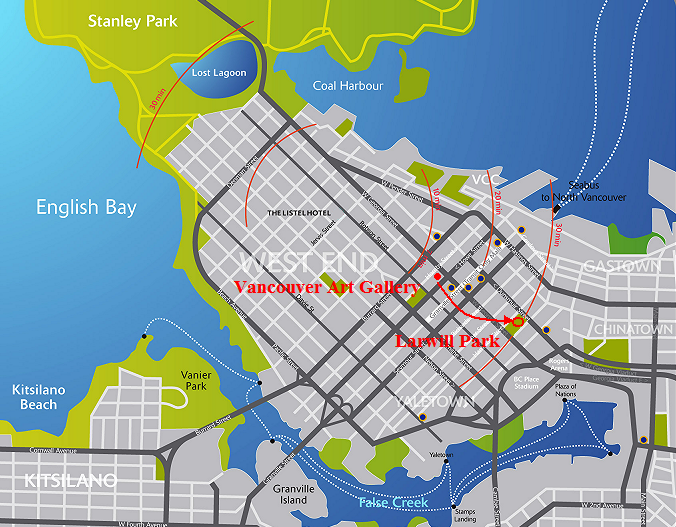
(vanmap1.png)
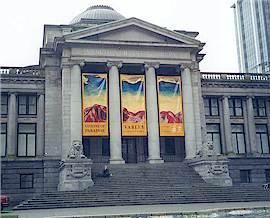
(vga01.jpg)


(park003.jpg)

So, you're quite enthusiastic about the new gallery, aren't you?

You're telling me.
But, Kato, have you ever been to the art gallery?
Yes, of course, I have. Do you think I'm a hopeless hobo without any sense of beauty? Look at those beautiful pictures in the above! I've posted them up there so that you would know for sure that I've got a sense of appreciation of fine arts.
I know what you mean, Kato, but those are pictures---not paintings. Most of the works displayed in the gallery are paintings, aren't they?
Yes, I'd say so. As far as I'm concerned, however, there is no difference between pictures and paintings. I can appreciate the beauty of both works. In any cae, there is another reason I quoted the above newspaper article.
Oh, is there? Tell me about it.
Well ... I was curious about the phrase, namely, "down-at-the-heels" in the above article. Diane, do you know the meaning of this phrase?
Yes, of course, I know. It means "seedy" or "dilapidated."
Gee ... amazing! Diane, you're quite knowledgeable!
Kato, it's common sense, isn't it?
I don't think so. I think I've heard of the expression before, and I've got a rough idea what it means, but I didn't know the exact meaning for sure. So I checked with thefreedictionary.com.

(downheel.gif)

You're quite right, Diane. It means "poor" or "shabby." But tell me why it means "seedy" or "dilapidated" in the first place? It doesn't make sense to me.

Well ...
Diane, tell me how come "down-at-the-heels" means "seedy" or "dilapidated."
Well ... come to think of it, ...
what?
Kato ... come to think of it, ... beats the hell out of me.
I've come up with the explanation on the net.

(socks99.jpg)
"Down-at-the-heels" means a run-down condition.
It is one of those figurative expressions that many people use all the time without really knowing for sure where it came from and what it literally means.
Actually it originated several hundred years ago in a different form.
From the 16th to the 18th centuries, out at heels was a common phrase in both literal and figurative contexts.
Literally out at heels meant with stockings or shoes worn through at the heel.
For example, "Some riche snudges...go with their hose out at heles" (1553, Oxford English Dictionary).
SOURCE:
Down at Heel: Origin and Meaning of the Expression

Ummm ... quite interesting, isn't it?

Yes, it certainly is! By the way, there is another phrase, which is quite new to me.
What is it, Kato?
Pyrrhic victory. Diane, do you know what it means?
Yes, of course, I know. It means "a victory achieved at too great a cost."
Gee ... Diane, you know it, don't you?
Kato, it's common sense, isn't it?
I don't think so. To tell you the truth, I've never heard of it. Well ... I might've heard of it, but I might've simply ignored the phrase because it sounds quite Greek to me. In any case, when I came across the phrase in the papers, I looked into thefreedictionary.com.

(pyrrhic02.gif)

You're quite right, Diane. It means "a victory that is offset by staggering losses." But tell me why "Pyrrhic victory" means "a victory achieved at too great a cost"?

Well ... once upon a time, there was a big fight called "Pyrrhic War."
Oh ... was there? Where? and when?
Well ... it happened a long time ago.
How long ago?
Probably ... thousands of years ago... Maybe, some three thousands years ago, I suppose.
And where did it take place?
In ancient Greece or, maybe, in ancient Rome ... I'm not too sure ... well ... beats the heck out of me.
Pyrrhic War
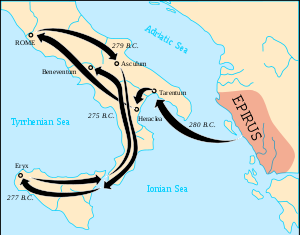
(pyrrhic90.png)
The Pyrrhic War (280–275 BC) was a complex series of battles and shifting political alliances among the Greeks (specifically Epirus, Macedonia, and the city states of Magna Graecia), Romans, the Italian peoples (primarily the Samnites and the Etruscans), and the Carthaginians.
The Pyrrhic War initially started as a minor conflict between Rome and the city of Tarentum over a naval treaty violation by one of the Roman consuls.
Tarentum had, however, lent aid to the Greek ruler Pyrrhus of Epirus in his conflict with Korkyra, and requested military aid from Epirus.
Pyrrhus honored his obligation to Tarentum and joined the complex series of conflicts involving Tarentum and the Romans, Samnites, Etruscans, and Thurii (as well as other cities of Magna Graecia).
Pyrrhus also involved himself in the internal political conflicts of Sicily, as well as the Sicilian struggle against Carthaginian dominance.

(pyrrhic06.jpg)
Pyrrhus' involvement in the regional conflicts of Sicily reduced the Carthaginian influence there drastically.
In Italy, his involvement seems to have been mostly ineffectual but had long term implications.
The Pyrrhic war proved both that the states of ancient Greece had essentially become incapable of defending the independent colonies of Magna Graecia and that the Roman legions were capable of competing with the armies of the Hellenistic kingdoms---the dominant Mediterranean powers of the time.
This opened the way for Roman dominance over the city states of Magna Graecia and advanced the Roman consolidation of power in Italy greatly.
Rome's proven record in international military conflicts would also aid its resolve in its rivalry with Carthage, which was eventually to culminate in the Punic Wars.
Linguistically, the Pyrrhic War is the source of the expression "Pyrrhic victory," a term for a victory won at too high a cost.
Its origin can be seen in Plutarch's description of Pyrrhus' reaction to the report of a victorious battle.
From "Pyrrhic War"
Wikipedia, the free encyclopedia

(pyrrhic90.png)
The Pyrrhic War (280–275 BC) was a complex series of battles and shifting political alliances among the Greeks (specifically Epirus, Macedonia, and the city states of Magna Graecia), Romans, the Italian peoples (primarily the Samnites and the Etruscans), and the Carthaginians.
The Pyrrhic War initially started as a minor conflict between Rome and the city of Tarentum over a naval treaty violation by one of the Roman consuls.
Tarentum had, however, lent aid to the Greek ruler Pyrrhus of Epirus in his conflict with Korkyra, and requested military aid from Epirus.
Pyrrhus honored his obligation to Tarentum and joined the complex series of conflicts involving Tarentum and the Romans, Samnites, Etruscans, and Thurii (as well as other cities of Magna Graecia).
Pyrrhus also involved himself in the internal political conflicts of Sicily, as well as the Sicilian struggle against Carthaginian dominance.

(pyrrhic06.jpg)
Pyrrhus' involvement in the regional conflicts of Sicily reduced the Carthaginian influence there drastically.
In Italy, his involvement seems to have been mostly ineffectual but had long term implications.
The Pyrrhic war proved both that the states of ancient Greece had essentially become incapable of defending the independent colonies of Magna Graecia and that the Roman legions were capable of competing with the armies of the Hellenistic kingdoms---the dominant Mediterranean powers of the time.
This opened the way for Roman dominance over the city states of Magna Graecia and advanced the Roman consolidation of power in Italy greatly.
Rome's proven record in international military conflicts would also aid its resolve in its rivalry with Carthage, which was eventually to culminate in the Punic Wars.
Linguistically, the Pyrrhic War is the source of the expression "Pyrrhic victory," a term for a victory won at too high a cost.
Its origin can be seen in Plutarch's description of Pyrrhus' reaction to the report of a victorious battle.
From "Pyrrhic War"
Wikipedia, the free encyclopedia

So, Kato, you looked into Wikipedia for me, didn't you?

Yes, I did. Besides, I was quite curious about this particular war, which turned out the source of the expression "Pyrrhic victory." It's really amazing! The war took place 2300 years ago, and the newspaper man still uses this phrase today. It is unthinkable in Japan.
I think, it's an intellectual tradition in the West to refer to the ancient Roman and Greek history.
Yes, come to think of it, it has something to do with the Renaissance.
How do you mean, Kato?
Well ... in Europe, people started to study the ancient Roman and Greek history when the Europeans cerebrated the Renaissance.
So, Kato, you don't know anything about ancient wars, do you?
Yes, of course, I know.
Oh ... do you? Like what?
To me, the battle of Thermopylae is more fascinating and exciting than the Pyrrhic War.
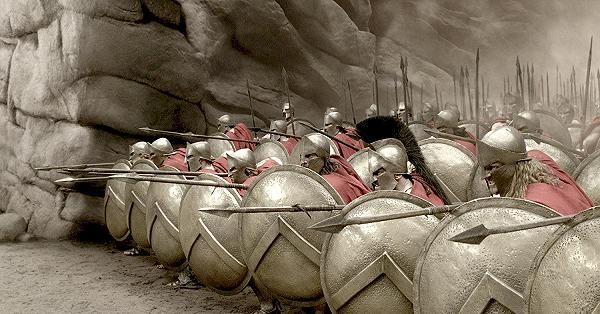
(300war2.jpg)
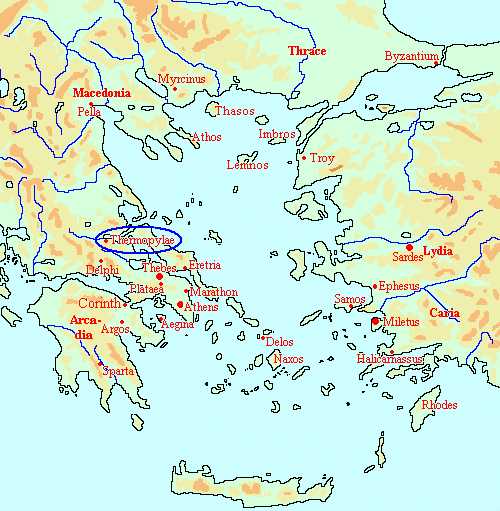
(300map2.gif)
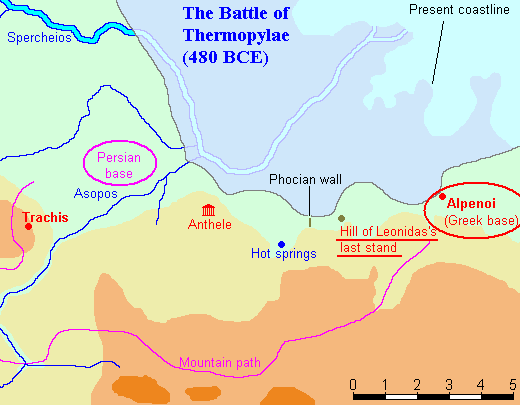
(thermopylae2.gif)

How come the battle of Thermopylae is more fascinating and exciting you than the Pyrrhic War, Kato?

...'Cause the following DVD gave me the hell of a bloody impression!

(lib30429.jpg)
■“Actual Shelf Page”

(lib30429d.jpg)
■“Actual Catalogue Page”

Kato, did you see the above movie on June 22, 2012?

Yes, I did. As I commented, the movie gave me a visual experience of the battle of Thermopylae.
Battle of Thermopylae

(300war4.jpg)
The Battle of Thermopylae was fought between an alliance of Greek city-states, led by King Leonidas of Sparta, and the Persian Empire of Xerxes I over the course of three days, during the second Persian invasion of Greece.
It took place simultaneously with the naval battle at Artemisium, in August or September 480 BC, at the narrow coastal pass of Thermopylae ('The Hot Gates').
The Persian invasion was a delayed response to the defeat of the first Persian invasion of Greece, which had been ended by the Athenian victory at the Battle of Marathon in 490 BC.
Xerxes had amassed a huge army and navy, and set out to conquer all of Greece.
The Athenian general Themistocles had proposed that the allied Greeks block the advance of the Persian army at the pass of Thermopylae, and simultaneously block the Persian navy at the Straits of Artemisium.
A Greek force of approximately 7,000 men marched north to block the pass in the summer of 480 BC.
The Persian army, alleged by the ancient sources to have numbered over one million but today considered to have been much smaller (various figures are given by scholars ranging between about 100,000 and 150,000), arrived at the pass in late August or early September.
The vastly outnumbered Greeks held off the Persians for seven days (including three of battle) before the rear-guard was annihilated in one of history's most famous last stands.
During two full days of battle the small force led by King Leonidas I of Sparta blocked the only road by which the massive Persian army could pass.
After the second day of battle a local resident named Ephialtes betrayed the Greeks by revealing a small path that led behind the Greek lines.
Leonidas, aware that his force was being outflanked, dismissed the bulk of the Greek army and remained to guard the rear with 300 Spartans, 700 Thespians, 400 Thebans and perhaps a few hundred others, most of whom were killed.
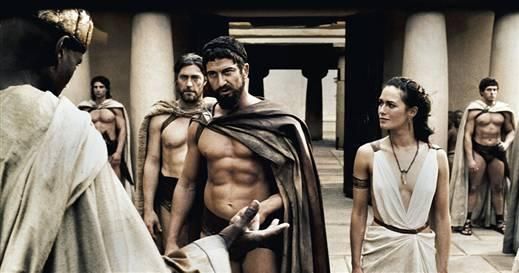
(300war3.jpg)
From "Battle of Thermopylae"
Wikipedia, the free encyclopedia

(300war4.jpg)
The Battle of Thermopylae was fought between an alliance of Greek city-states, led by King Leonidas of Sparta, and the Persian Empire of Xerxes I over the course of three days, during the second Persian invasion of Greece.
It took place simultaneously with the naval battle at Artemisium, in August or September 480 BC, at the narrow coastal pass of Thermopylae ('The Hot Gates').
The Persian invasion was a delayed response to the defeat of the first Persian invasion of Greece, which had been ended by the Athenian victory at the Battle of Marathon in 490 BC.
Xerxes had amassed a huge army and navy, and set out to conquer all of Greece.
The Athenian general Themistocles had proposed that the allied Greeks block the advance of the Persian army at the pass of Thermopylae, and simultaneously block the Persian navy at the Straits of Artemisium.
A Greek force of approximately 7,000 men marched north to block the pass in the summer of 480 BC.
The Persian army, alleged by the ancient sources to have numbered over one million but today considered to have been much smaller (various figures are given by scholars ranging between about 100,000 and 150,000), arrived at the pass in late August or early September.
The vastly outnumbered Greeks held off the Persians for seven days (including three of battle) before the rear-guard was annihilated in one of history's most famous last stands.
During two full days of battle the small force led by King Leonidas I of Sparta blocked the only road by which the massive Persian army could pass.
After the second day of battle a local resident named Ephialtes betrayed the Greeks by revealing a small path that led behind the Greek lines.
Leonidas, aware that his force was being outflanked, dismissed the bulk of the Greek army and remained to guard the rear with 300 Spartans, 700 Thespians, 400 Thebans and perhaps a few hundred others, most of whom were killed.

(300war3.jpg)
From "Battle of Thermopylae"
Wikipedia, the free encyclopedia

So, Kato, you love this fast-paced, action-packed movie---especially, combined action scenes of slow-motion and fast-forward movement, don't you?

Yes, I do. These fighting scenes are so impressive and shocking that this technique might have influenced in making the violent scenes of "Spartacus, blood and sand"---a dazzling and fascinating television program in 2010.
Well ... I don't like wars and battles, but I'm glad you're now familiar with the expression---"Pyrrhic victory."
Yes, yes, yes, ... I think I'm westernized as far as the intellectural tradition is concerned.

【Himiko's Monologue】

The Vancouver Art Gallery was founded in 1931 and had its first home at 1145 West Georgia Street.
In 1983 it moved to the current Hornby Street location, the former provincial courthouse.

(vga01.jpg)
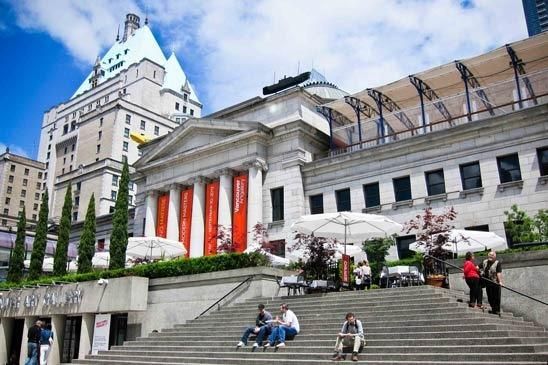
(vga08.jpg)
It was renovated at a cost of $20 million by architect Arthur Erickson, which completed his modern three city-block Robson Square complex.
The Gallery connects to the rest of the complex via an underground passage below Robson Street to an outdoor plaza, restaurants, the University of British Columbia's downtown satellite campus, government offices, and the new Law Courts at the southern end.
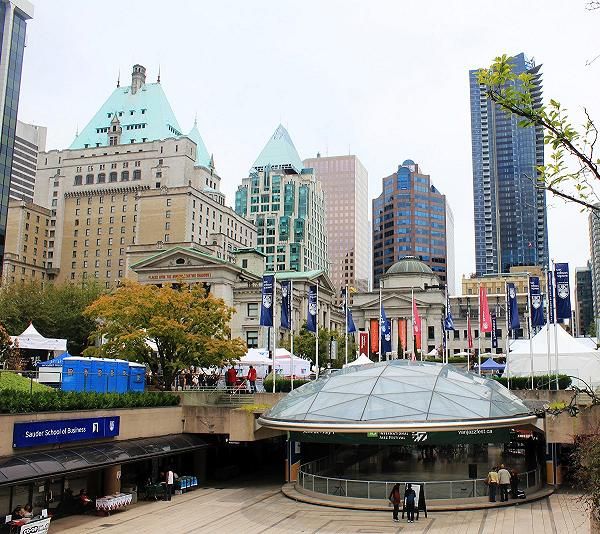
(vga09.jpg)
It is the fifth-largest art gallery in Canada and the largest in Western Canada.
Its permanent collection of about 10,000 artworks includes more than 200 major works by Emily Carr, the Group of Seven, Jeff Wall and Marc Chagall.
When you happen to be in Vancouver, please visit the gallery.
In any case, I hope Kato will write another interesting article soon.
So please come back to see me.
Have a nice day!
Bye bye ...


The Vancouver Art Gallery was founded in 1931 and had its first home at 1145 West Georgia Street.
In 1983 it moved to the current Hornby Street location, the former provincial courthouse.

(vga01.jpg)

(vga08.jpg)
It was renovated at a cost of $20 million by architect Arthur Erickson, which completed his modern three city-block Robson Square complex.
The Gallery connects to the rest of the complex via an underground passage below Robson Street to an outdoor plaza, restaurants, the University of British Columbia's downtown satellite campus, government offices, and the new Law Courts at the southern end.

(vga09.jpg)
It is the fifth-largest art gallery in Canada and the largest in Western Canada.
Its permanent collection of about 10,000 artworks includes more than 200 major works by Emily Carr, the Group of Seven, Jeff Wall and Marc Chagall.
When you happen to be in Vancouver, please visit the gallery.
In any case, I hope Kato will write another interesting article soon.
So please come back to see me.
Have a nice day!
Bye bye ...


If you've got some time,
Please read one of the following artciles:

(sylvie121.jpg)
■"Roly-poly in the wild"
■"Silence is dull"
■"Zen and Chi Gong"
■"Piano Lesson"
■"Dangerous Relation"
■"Electra Complex"

(juneswim.jpg)
■"Covent Garden"
■"Fatal Relation"
■"Notre Dame"
■"Anne Frank"
■"Biker Babe"
■"Diane Girdles the Globe"
■"Diane in Casablanca"
■"Infidelity Neighbourhood"
■"Forest Bathing"
■"Enjoy Ramen!"
■"Sex, Violence, Love"

■"Halifax to Vancouver"
■"A Thread of Destiny"
■"Fujiyama Geisha"
■"Beaver Lake"
■"God is Near!"
■"Holy Cow@Rose Garden"
■"Vancouver Earthquake"
■"Birthplace"

■"KIFF"
■"You Love Japan, eh?"
■"Eight Bridges"
■"First Love"
■"Fright on Flight"
■"Boy's Movie"
■"From Summer to Eternity"
■"Sōseki & Glenn Gould"

(biker302.jpg)
■"Dream Dream Dream"
■"In Search of Your Footprint"
■"Little Night Music"
■"Merry X'mas"
■"Happy New Year!"
■"Long live Diane!"
■"Mona Lisa"
■"Flu Shot"
■"Selfish TD Bank"
■"Talk with Mozart"

■"Bliss for Diane!"
■"Romantic Bohemian"
■"TD Bank or Mozart?"
■"Diane@TD Bank"
■"Tear Jerker"
■"Diane in Chorus Line"
■"Pork or Friend?"
■"Easter Bloopers"
■"Beauty is Heart-deep"
■"Romance@South Pacific"


Hi, I'm June Adams.
Bilbao is the capital of the province of Biscay in the autonomous community of the Basque Country in Spain.
With a population of 353,187 as of 2010, it is the largest city of its autonomous community and the tenth largest in Spain.
Bilbao lies within one of the most populous metropolitan areas in northern Spain.

(bilbao01b.jpg)
Since its foundation in the early 14th century by Diego López V de Haro, head of the powerful Haro family, Bilbao was a commercial hub that enjoyed significant importance in the Green Spain, mainly thanks to its port activity based on the export of iron extracted from the Biscayan quarries.
Throughout the nineteenth century and beginnings of the twentieth, Bilbao experienced heavy industrialization that made it the centre of the second industrialized region of Spain, behind Barcelona.
This was joined by an extraordinary population explosion that prompted the annexation of several adjacent municipalities.
Nowadays, Bilbao is a vigorous service city that is experiencing an ongoing social, economic, and aesthetic revitalization process, started by the symbolic Bilbao Guggenheim Museum, and continued by infrastructure investments, such as the airport terminal, the rapid transit system, and the tram line.

(bilbao02.jpg)

ところで、愛とロマンに満ちた
レンゲさんのお話をまとめて
『レンゲ物語』を作りました。
もし、レンゲさんの記事をまとめて読みたいならば、
次のリンクをクリックしてくださいね。
■『愛とロマンのレンゲ物語』

■『軽井沢タリアセン夫人 - 小百合物語』
とにかく、今日も一日楽しく愉快に
ネットサーフィンしましょうね。
じゃあね。







0 件のコメント:
コメントを投稿